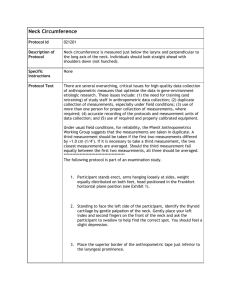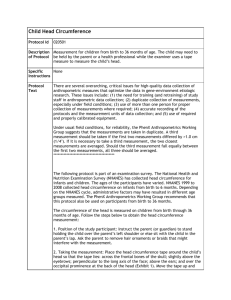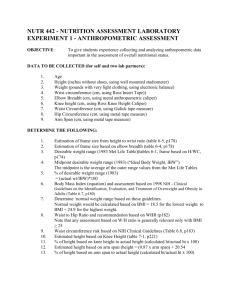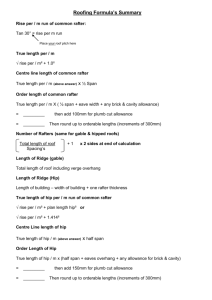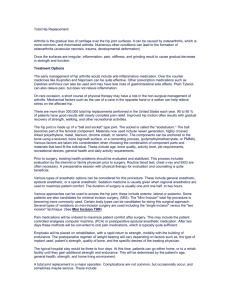Hip Circumference v1
advertisement
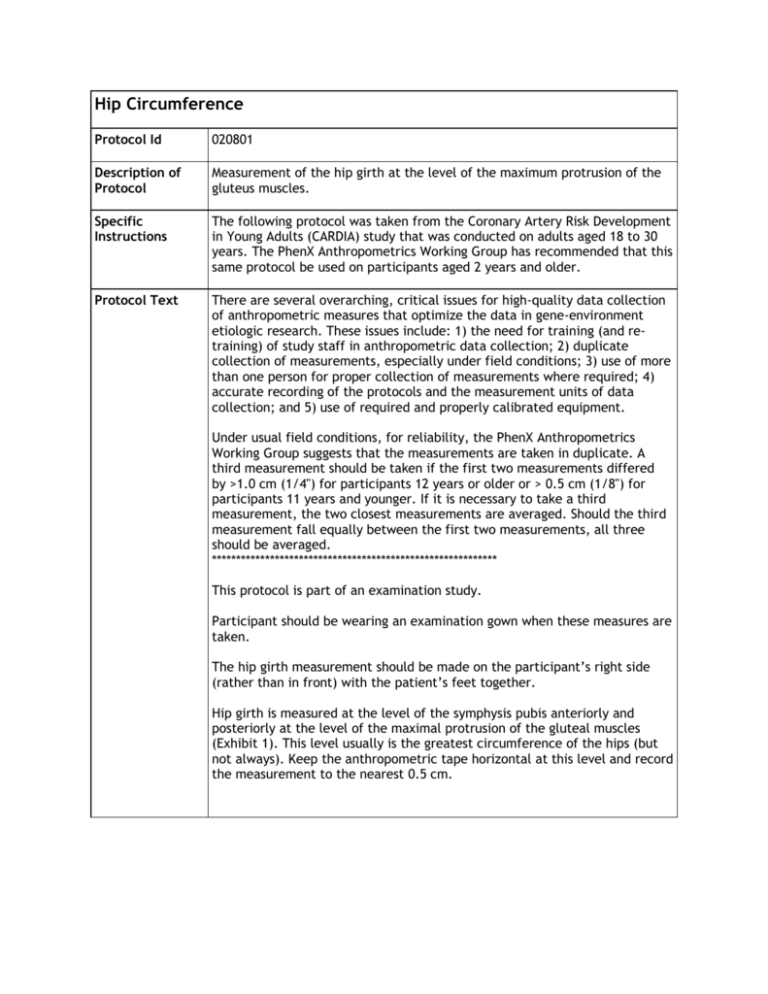
Hip Circumference Protocol Id 020801 Description of Protocol Measurement of the hip girth at the level of the maximum protrusion of the gluteus muscles. Specific Instructions The following protocol was taken from the Coronary Artery Risk Development in Young Adults (CARDIA) study that was conducted on adults aged 18 to 30 years. The PhenX Anthropometrics Working Group has recommended that this same protocol be used on participants aged 2 years and older. Protocol Text There are several overarching, critical issues for high-quality data collection of anthropometric measures that optimize the data in gene-environment etiologic research. These issues include: 1) the need for training (and retraining) of study staff in anthropometric data collection; 2) duplicate collection of measurements, especially under field conditions; 3) use of more than one person for proper collection of measurements where required; 4) accurate recording of the protocols and the measurement units of data collection; and 5) use of required and properly calibrated equipment. Under usual field conditions, for reliability, the PhenX Anthropometrics Working Group suggests that the measurements are taken in duplicate. A third measurement should be taken if the first two measurements differed by >1.0 cm (1/4") for participants 12 years or older or > 0.5 cm (1/8") for participants 11 years and younger. If it is necessary to take a third measurement, the two closest measurements are averaged. Should the third measurement fall equally between the first two measurements, all three should be averaged. *********************************************************** This protocol is part of an examination study. Participant should be wearing an examination gown when these measures are taken. The hip girth measurement should be made on the participant’s right side (rather than in front) with the patient’s feet together. Hip girth is measured at the level of the symphysis pubis anteriorly and posteriorly at the level of the maximal protrusion of the gluteal muscles (Exhibit 1). This level usually is the greatest circumference of the hips (but not always). Keep the anthropometric tape horizontal at this level and record the measurement to the nearest 0.5 cm. Exhibit 1. Location of Hip Girth Measurement (from CARDIA) Rounding rule: If measuring to the nearest half centimeter, round according to the following example: 86.1 and 86.2 would round to 86.0; 86.3, 86.4, 86.6, and 86.7 would round to 86.5; 86.8 and 86.9 would round to 87.0. Measures of 87.0 and 87.5 should be recorded as such. The greatest source of error for this measurement is due to not having the tape horizontal. If the participant is large, it is permissible to have him/her hold one end of the tape while walking the tape around for this measurement. NOTE: For large participants, two technicians will be required to perform the measurement. Take care not to offend the person being measured; be as discreet as possible when changing to the larger tape measure. Selection Rationale The measurement protocol has been used by the CARDIA study. It is a relatively large dataset approximately equally split between men and women, African Americans and whites, across a broad range of ages starting at 18 years. Source Coronary Artery Risk Development in Young Adults (CARDIA) Study. (19951996). Year 10 Manual of Operations - Anthropometric Manual. Language English Participant 2 years of age and older Personnel and Training Required Technicians should be trained in the basic techniques of anthropometric measurements. Equipment Needs Flexible measurement tape that exceeds 72 inches or 200 cm. Standards Standard Name ID Common Data Elements (CDE) Person Hip Circumference Value 2793486 CDE Browser Logical Observation Identifiers Names and Codes (LOINC) PhenX - hip circumference protocol 62409-8 LOINC General References None Protocol Type Physical Measurement Source Derived Variables Waist to Hip Ratio (WHR). Requirements Requirement Category Required Average time of greater than 15 minutes in an unaffected individual No Average time of greater than 15 minutes in an unaffected individual Major equipment No This measure requires a specialized measurement device that may not be readily available in every setting where genome wide association studies are being conducted. Examples of specialized equipment are DEXA, Echocardiography, and Spirometry Specialized requirements for biospecimen collection No This protocol requires that blood, urine, etc. be collected from the study participants. Specialized training This measure requires staff training in the protocol methodology and/or in the conduct of the data analysis. No
